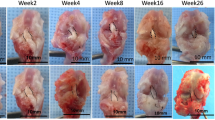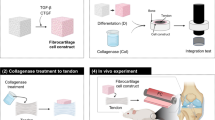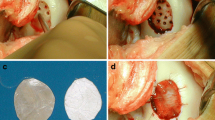Abstract
The fibrocartilage transition zone in the direct bone-tendon junction reduces stress concentration and protects the junction from failure. Unfortunately, bone-tendon junctions often heal without fibrocartilage transition zone regeneration. We hypothesized articular cartilage grafts could increase fibrocartilage transition zone regeneration. Using a goat partial patellectomy repair model, autologous articular cartilage was harvested from the excised distal third patella and interposed between the residual proximal two-thirds bone fragment and tendon during repair in 36 knees. We evaluated fibrocartilage transition zone regeneration, bone formation, and mechanical strength after repair at 6, 12, and 24 weeks and compared them with direct repair. Autologous articular cartilage interposition resulted in more fibrocartilage transition zone regeneration (69.10% ± 14.11% [mean ± standard deviation] versus 8.67% ± 7.01% at 24 weeks) than direct repair at all times. There was no difference in the amount of bone formation and mechanical strength achieved. Autologous articular cartilage interposition increases fibrocartilage transition zone regeneration in bone-tendon junction healing, but additional research is required to ascertain the mechanism of stimulation and to establish the clinical applicability.






Similar content being viewed by others
References
Aoki M, Oguma H, Fukushima S, Ishii S, Ohtani S, Murakami G. Fibrous connection to bone after immediate repair of the canine infraspinatus: the most effective bony surface for tendon attachment. J Shoulder Elbow Surg. 2001;10:123–128.
Benjamin M, Evans EJ. Fibrocartilage: a review. J Anat. 1990;171:1–15.
Benjamin M, Newell RL, Evans EJ, Ralphs JR, Pemberton DJ. The structure of the insertions of the tendons of biceps brachii, triceps and brachialis in elderly dissecting room cadavers. J Anat. 1992;180:327–332.
Benjamin M, Ralphs JR. Fibrocartilage in tendons and ligaments: an adaptation to compressive load. J Anat. 1998;193:481–494.
Buckwalter J, Mow VC, Ratcliffe A. Restoration of injured or degenerated articular cartilage. J Am Acad Orthop Surg. 1994;2:192–201.
Chiquet M. Regulation of extracellular matrix gene expression by mechanical stress. Matrix Biol. 1999;18:417–426.
Chubinskaya S, Kuettner KE. Regulation of osteogenic proteins by chondrocytes. Int J Biochem Cell Biol. 2003;35:1323–1340.
Cooper RR, Misol S. Tendon and ligament insertion: a light and electron microscopic study. J Bone Joint Surg Am. 1970;52:1–20.
Crowninshield RD, Pope MH. The strength and failure characteristics of rat medial collateral ligaments. J Trauma. 1976;16:99–105.
Evans EJ, Benjamin M, Pemberton DJ. Fibrocartilage in the attachment zones of the quadriceps tendon and patellar ligament of man. J Anat. 1990;171:155–162.
Frowen P, Benjamin M. Variations in the quantity of uncalcified fibrocartilage at the insertion of the extrinsic calf muscles in the foot. J Anat. 1995;186:417–421.
Galatz LM, Sandell LJ, Rothermich SY, Das R, Mastny A, Havlioglu N, Silva MJ, Thomopoulos S. Characteristics of the rat supraspinatus tendon during tendon-to-bone healing after acute injury. J Orthop Res. 2006;24:541–550.
Gao J, Messner K, Ralphs JR, Benjamin M. An immunohistochemical study of enthesis development in the medial collateral ligament of the rat knee joint. Anat Embryol. 1996;194:399–406.
Huangfu X, Zhao J. Tendon-bone healing enhancement using injectable tricalcium phosphate in a dog anterior cruciate ligament reconstruction model. Arthroscopy. 2007;23:455–462.
Hung LK, Lee SY, Leung KS, Chan KM, Nicholl LA. Partial patellectomy for patellar fracture: tension band wiring and early mobilization. J Orthop Trauma. 1993;7:252–260.
Leddy JP. Flexor tendons: acute injuries. In: Green DP, ed. Green’s Operative Hand Surgery. 5th ed. Philadelphia, PA: Elsevier/Churchill Livingstone; 2005:219–276.
Leung KS, Qin L, Fu LK, Chan CW. A comparative study of bone to bone repair and bone to tendon healing in patella-patellar tendon complex in rabbits. Clin Biomech. 2002;17:594–602.
Liu SH, Hang DW, Gentili A, Finerman GA. MRI and morphology of the insertion of the patellar tendon after graft harvesting. J Bone Joint Surg Br. 1996;78:823–826.
Ma CB, Kawamura S, Deng XH, Ying L, Schneidkraut J, Hays P, Rodeo SA. Bone morphogenetic proteins-signaling plays a role in tendon-to-bone healing: a study of rhBMP-2 and noggin. Am J Sports Med. 2007;35:597–604.
Mankin HJ. The response of articular cartilage to mechanical injury. J Bone Joint Surg Am. 1982;64:460–466.
Mihelic R, Pecina M, Jelic M, Zoricic S, Kusec V, Simic P, Bobinac D, Lah B, Legovic D, Vukicevic S. Bone morphogenetic protein-7 (osteogenic protein-1) promotes tendon graft integration in anterior cruciate ligament reconstruction in sheep. Am J Sports Med. 2004;32:1619–1625.
Noyes FR, DeLucas JL, Torvik PJ. Biomechanics of anterior cruciate ligament failure: an analysis of strain-rate sensitivity and mechanisms of failure in primates. J Bone Joint Surg Am. 1974;56:236–253.
Oguma H, Murakami G, Takahashi-Iwanaga H, Aoki M, Ishii S. Early anchoring collagen fibers at the bone tendon interface are conducted by woven bone formation: light microscope and scanning electron microscope observation using a canine model. J Orthop Res. 2001;19:873–880.
Qin L, Leung KS, Chan CW, Fu LK, Rosier R. Enlargement of remaining patella after partial patellectomy in rabbits. Med Sci Sports Exerc. 1999;31:502–506.
Ralphs JR, Benjamin M, Wagget AD, Russell DC, Messner K, Gao J. Regional differences in cell shape and gap junction expression in rat Achilles tendon: relation to fibrocartilage differentiation. J Anat. 1998;193:215–222.
Rodeo SA, Arnoczky SP, Torzilli PA, Hidaka C, Warren RF. Tendon-healing in a bone tunnel: a biomechanical and histological study in the dog. J Bone Joint Surg Am. 1993;75:1795–1803.
Rodeo SA, Suzuki K, Deng XH, Wozney J, Warren RF. Use of recombinant human bone morphogenetic protein–2 to enhance tendon healing in a bone tunnel. Am J Sports Med. 1999;27:476–488.
Sarasa-Renedo A, Chiquet M. Mechanical signals regulating extracellular matrix gene expression in fibroblasts. Scand J Med Sci Sports. 2005;15:223–230.
Suresh S. Graded materials for resistance to contact deformation and damage. Science. 2001;292:2447–2451.
Vogel KG, Koob TJ. Structural specialization in tendons under compression. Int Rev Cytol. 1989;115:267–293.
Wilson I, Gamble M. The hematoxylins and eosin. In: Bancroft JD, Gamble M, eds. Theory and Practice of Histological Techniques. 6th ed. London, UK: Churchill Livingstone; 2007:135–136.
Wong MW, Qin L, Lee KM, Tai KO, Chong WS, Leung KS, Chan KM. Healing of bone-tendon junction in a bone trough: a goat partial patellectomy model. Clin Orthop Relat Res. 2003;413:291–302.
Woo SL, Buckwalter JA. Injury and repair of the musculoskeletal soft tissues. J Orthop Res. 1988;6:907–931.
Woo SL, Peterson RH, Ohland KJ, Sites TJ, Danto MI. The effects of strain rate on the properties of the medial collateral ligament in skeletally immature and mature rabbits: a biomechanical and histological study. J Orthop Res. 1990;8:712–721.
Acknowledgments
We thank J. Tai and W. Chong for assistance in animal surgery and sample processing.
Author information
Authors and Affiliations
Corresponding author
Additional information
One or more of the authors (MWNW, LQ, KSL) have received funding from Research Grants Council Earmarked Grant (Ref. CUHK 427597M).
Each author certifies that his or her institution has approved the animal protocol for this investigation and that all investigations were conducted in conformity with ethical principles of research.
About this article
Cite this article
Wong, M.W.N., Qin, L., Lee, K.M. et al. Articular Cartilage Increases Transition Zone Regeneration in Bone-tendon Junction Healing. Clin Orthop Relat Res 467, 1092–1100 (2009). https://doi.org/10.1007/s11999-008-0606-8
Received:
Accepted:
Published:
Issue Date:
DOI: https://doi.org/10.1007/s11999-008-0606-8




